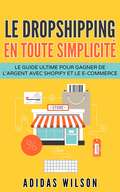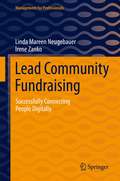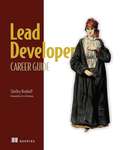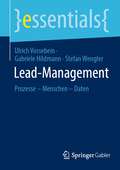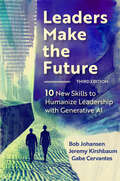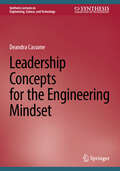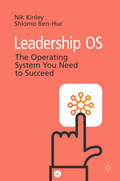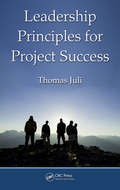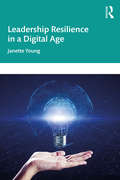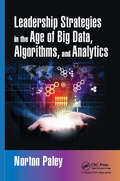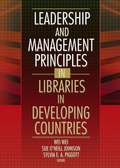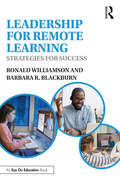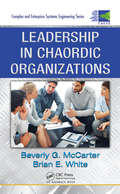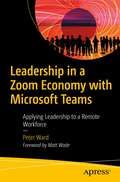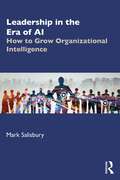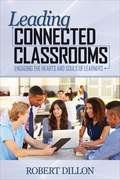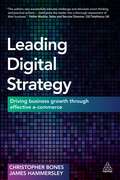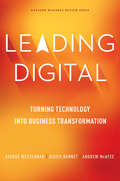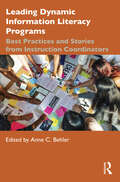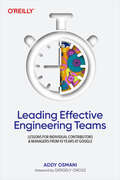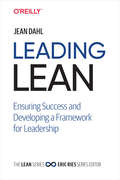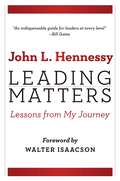- Table View
- List View
Le dropshipping en toute simplicité: Le guide ultime pour gagner de l'argent avec Shopify et le e-commerce
by Adidas WilsonLe Dropshipping est une méthode de vente au détail où les boutiques ne stockent pas réellement leurs produits. Lorsqu’un client achète un produit, le vendeur l'achète à une autre partie et l'expédie directement au client. Le commerçant ne manipule ni ne voit le produit. Le dropshipping diffère du modèle de vente au détail conventionnel en ce sens que, dans ce cas, le vendeur ne possède pas de stock. Il ou elle achète une commande à un tiers. Comme tout le reste, le modèle du dropshipping présente des inconvénients et des avantages. Vous avez besoin de moins de capital : c'est sans doute le plus grand avantage. Vous n'avez pas besoin de milliers de dollars pour lancer une boutique de e-commerce. Les détaillants conventionnels doivent disposer d'un capital énorme pour constituer leur stock. Dans le cas du dropshipping, vous n'achetez un produit que lorsqu'un client a passé une commande et effectué le paiement. Un investissement initial dans le stock n'est pas nécessaire. Facile à démarrer : une entreprise de e-commerce est beaucoup plus facile à gérer lorsque vous ne manipulez pas de produits physiques. Vous n'aurez pas à vous soucier d'un entrepôt, de l'emballage et de l'expédition, du suivi des stocks, de la gestion des retours, etc. Faibles frais généraux : puisque vous n'aurez pas à vous occuper d'un entrepôt ou à acheter des stocks, attendez-vous à de faibles frais généraux. Beaucoup de personnes gèrent une entreprise de dropshipping depuis leur bureau à domicile avec leur ordinateur portable et ne dépensent qu'environ 100 $ par mois. Les dépenses peuvent augmenter au fur et à mesure que votre entreprise se développe, mais elles resteront faibles. Emplacement flexible : si vous avez une connexion Internet, vous pouvez gérer votre entreprise de dropshipping de n'importe où.
Le guide ultime de Windows 10: Conseils et astuces pour gagner du temps et utiliser Windows 10 comme un pro
by Jon AlbertUn guide détaillé pour connaître les trucs et astuces de windows 10. Ce guide vous aidera à utiliser Windows 10 comme un pro, des trucs et astuces pour gagner du temps. Ce livre vous apprendra à : - Configurer l'explorateur Windows - Supprimer 'Bing' de microsoft edge - Configurer cortana - Prendre le contrôle de la mise à jour de Windows 10 - Se débarrasser de l'écran de connexion de Windows 10 - Désactiver le flash dans Edge Si vous voulez utiliser Windows 10 comme un Pro, alors ce livre est pour vous. --> Faites défiler jusqu'en haut de la page et cliquez sur ajouter au panier pour acheter instantanément Avis de non-responsabilité : Cet auteur et ou le(s) propriétaire(s) des droits ne font aucune réclamation, promesse ou garantie quant à l'exactitude, l'exhaustivité ou l'adéquation du contenu de ce livre, et rejette expressément toute responsabilité en cas d'erreur ou d'omission dans le contenu de celui-ci. Ce produit est destiné à un usage de référence uniquement.
Lead Community Fundraising: Successfully Connecting People Digitally (Management for Professionals)
by Linda Mareen Neugebauer Irene ZankoThe world is changing, and so are our donors. In the future, it will become even more important for organizations to find leads, supporters and new donors online - because digitization is a bottleneck in fundraising.This book highlights universal fundraising opportunities. It explains the fundamentals of lead community fundraising and why, especially in digital times, it is important to start with the people - the community. The main topic of the book is the current state of digital fundraising, which is becoming more and more important. More than 45 examples from international fundraising practices provide a valuable foundation for all practitioners in this field.
Lead Developer Career Guide
by Shelley BenhoffLearn the skills you need to be a lead developer, with expert advice on mentoring teams, handling clients and project managers, and keeping your head in emergencies.The Lead Developer Career Guide teaches you how to transition from an individual contributor to a thriving lead developer. It's packed with insider tips, tricks, and strategies drawn from author Shelley Benhoff's 25-year career in technology, providing vital insights for navigating the unique challenges and expectations of the lead developer role. This one-of-a-kind book demonstrates how critical thinking and communication skills can elevate your career. In the Lead Developer Career Guide you'll discover: • The key responsibilities of a lead developer • Techniques for writing effective technical documentation • Strategies for improving development processes • Best practices for communicating with non-technical clients • Methods for mentoring and inspiring a team • Approaches for delivering negative feedback constructively The Lead Developer Career Guide is filled with interviews and real-world case studies from industry professionals and esteemed tech experts. You'll learn how to become the public face for your development team, gathering feedback from your coworkers and communicating with clients and stakeholders. Plus, you'll find proven techniques to reliably calculate project estimates, plan a project from scratch, and mentor junior developers and peers alike. Foreword by Steve Buchanan. About the technology To be a successful Lead Developer you&’ll need more than just technical expertise. You&’ll be responsible for everything from facilitating architectural decisions that satisfy all stakeholders to mentoring your fellow developers. And you&’ll be on the hook for delivering great software on time and under budget. Are you ready for the challenge? This book will help get you there! About the book The Lead Developer Career Guide provides the techniques and wisdom you need to transition from individual contributor to lead developer. You&’ll learn how to collaborate effectively with executive leadership and project managers, present elegant solutions to clients, and think quickly in those inevitable emergencies. When all eyes are on you, this book will ensure you know exactly what to do. What's inside • Improving development processes • Mentoring and inspiring a team • Delivering negative feedback About the reader For aspiring lead developers. About the author Shelley Benhoff has over twenty-five years of experience in tech as a business owner, author, and speaker. The technical editor on this book was Stephen Mizell. Table of Contents 1 What is a lead developer? 2 Lead developer career trajectory 3 Learning lead developer skills 4 Learning any developer skill 5 Writing technical documentation 6 Optimizing the development process 7 Working with project teams 8 Speaking with clients 9 Being a mentor 10 Taking the lead 11 Leading with emotional intelligence 12 Being a successful lead developer
Lead-Management: Prozesse – Menschen – Daten (essentials)
by Ulrich Vossebein Gabriele Hildmann Stefan WenglerLead-Management ist eine der großen Herausforderungen im Vertrieb, da die Neukundengewinnung immer bedeutsamer wird. Dieses essential erläutert, wie durch den parallelen Ausbau der drei Basisdimensionen: Prozesse, Menschen und Daten Lead-Exzellenz erreicht werden kann. Hierzu sind zunächst die Rahmenbedingungen zu analysieren und zu bewerten. Anschließend müssen die Prozesse in eine Prozesslandkarte eingebunden, die Kompetenzprofile den neuen Anforderungen angepasst und die Datenbasis vervollständigt werden. Eine umfangreiche Checkliste zeigt auf, wie Unternehmen bei der Einführung oder Überarbeitung ihres bereits existierenden Lead-Managements sinnvollerweise vorgehen sollten.
Leaders Make the Future, Third Edition: Ten New Skills to Humanize Leadership with Generative AI
by Bob Johansen Jeremy Kirshbaum Gabe CervantesIn a world of chaos, how can generative AI help leaders lead?Over the next decade, all leaders will be augmented with some form of generative artificial intelligence, or GenAI. For the best leaders, this will mean dramatic improvement. For mediocre leaders, this will mean persistent confusion, distraction, and pretense. With futureback thinking—looking ten years ahead, then planning backward from future to next to now—this third edition of Leaders Make the Future shows how people can improve their leadership skills while expanding their human perspective.Now 75 percent revised and expanded with resources from the Institute for the Future, this new edition is organized around ten future leadership skills:Augmented futureback curiosityAugmented clarityAugmented dilemma flippingAugmented bio-engagingAugmented immersive learningAugmented depolarizingAugmented commons creatingAugmented smart mob swarmingAugmented strength with humilityHuman calmingAI-augmented leadership will be key for any organization to tackle the uncertainty of the future. And by incorporating practical methodologies, ethical guidelines, and innovative leadership practices, this book will help leaders develop their clarity and moderate their certainty.
Leadership Concepts for the Engineering Mindset (Synthesis Lectures on Engineering, Science, and Technology)
by Deandra CassoneThe book is intended to focus the engineer or technically minded individual on key aspects of their organization and how they can leverage their position to make a positive impact. The author explains why it is critical that the technically minded individual is aware of their corporate environment and how they and their organization fit within the organizational structure. Technical knowledge is just one component of success for engineers. The book provides readers with the tools to understand where they fit in with their organizations and what they can do to support corporate objectives. This book will address topics including gaining a big picture of an organization, defining what a specific organization does, understanding goals and objectives to align management strategies, budgeting, role in the supply chain, engineering career paths, and the importance of innovation.
Leadership OS: The Operating System You Need to Succeed
by Shlomo Ben-Hur Nik KinleyBased on years of original research, this book controversially counters almost every existing leadership model and approach.It shows how as leaders rise to senior levels, their roles become less about doing things that directly drive results and more about directing and supporting others to achieve objectives. Using case studies and research insights the authors reveal how leadership success is thus not so much about having the right core capabilities, but about creating the right environment.Using the analogy of a smartphone operating system (OS), the book presents a new way of thinking about leadership. The authors provide a clear and practical framework to follow and show how your leadership OS becomes the impact you have, the imprint you make and the foundation of your legacy as a leader.After reading it, you will learn:· How to diagnose the impact you have as a leader and understand the OS you create· How famous business and societal leaders have created effective – and sometimes ineffective – OSs· How to optimise your OS to produce the best results· How to get people working together effectively, and be a high-performing leaderProviding you with practical and easy to follow advice, this book will show you how leadership success is not about having the core capabilities, but about creating the right operating systems for your organisation.
Leadership Principles for Project Success
by Thomas JuliThis book is about project success and the secret to achieving this success, effective project leadership. Filled with samples, templates, and guidelines, it covers the five principles of effective project leadership: building vision, nurturing collaboration, promoting performance, cultivating learning, and ensuring results. Using nontechnical lang
Leadership Resilience in a Digital Age
by Janette YoungThe book focusses on the challenges faced in the digital age, and the increasing demands for continuous change in an inter-connected digital world. The book presents stories about how leaders have faced significant challenges and pressure, and how they have used these experiences as catalysts to transform, flourish, and develop personal resilience. The book explores the digital journey, ethical issues, teamwork, styles of leadership, agile, collaboration, trust, culture, psychological safety, self-awareness, vulnerability, conversation, positivity, emotional intelligence, creativity, inner knowing and the dark side of leadership. Drawing on the experiences of leaders in the creative, digital and technology sectors in the UK, and using their voice throughout, has resulted in proposing several internal and external strategic solutions to help the reader become more personally resilient. The book explores the impact of continuous change within a digital age, presenting the facets necessary to become a Digital Sage in an increasingly chaotic world. With a focus on creativity, innovation and mind and body awareness the leader as a Digital Sage arises to encourage resilience in a digital age. The book does not assume prior knowledge of the field of resilience and is ideal for executive education courses, and for leaders and managers seeking personal and professional transformation.
Leadership Strategies in the Age of Big Data, Algorithms, and Analytics
by Norton PaleyHarnessing the power of technology is one of the key measures of effective leadership. Leadership Strategies in the Age of Big Data, Algorithms, and Analytics will help leaders think and act like strategists to maintain a leading-edge competitive advantage. Written by a leading expert in the field, this book provides new insights on how to successfully transition companies by aligning an organization’s culture to accept the benefits of digital technology. The author emphasizes the importance of creating a team spirit with employees to embrace the digital age and develop strategic business plans that pinpoint new markets for growth, strengthen customer relationships, and develop competitive strategies. Understanding how to deal with inconsistencies when facts generated by data analytics disagree with your own experience, intuition, and knowledge of the competitive situation is key to successful leadership.
Leadership and Management Principles in Libraries in Developing Countries
by Wei Wei Sue O'Neill JohnsonLearn leadership skills from achievements at special libraries in Asia, Africa, Eastern Europe, and Central America! Leadership and Management Principles in Libraries in Developing Countries is a compilation of success stories epitomizing management and leadership strategies from developing nations around the globe. This book focuses on library administrators from Asia, Africa, Eastern Europe, and Central America who have significantly transformed their library services in spite of limited funds and a lack of resources. You'll learn about their achievements, their techniques, and the strengths and skills they used-which can help you become a stronger leader at your own library. Leadership and Management Principles in Libraries in Developing Countries is a collection of selected entries to the Special Libraries Association Leadership and Management Division&’s 2003 International Paper Competition for special librarians in developing countries. Each author describes the effective leadership and management that made their special library initiatives successful, providing references, tables, step-by-step instructions, and handy checklists for other librarians to use.In Leadership and Management Principles in Libraries in Developing Countries, library officials discuss the development of successful programs at special libraries such as: the Indian Institute of Technology in Delhi, India-where a team of people with diverse backgrounds worked together to digitally modernize their traditional library the Agricultural Libraries and Special Libraries in Tropical Biology located in Indonesia-where special librarians found innovative ways to access funding support and expertise from foreign institutions, international relief agencies, and library associations the Information Resource Centre at The Mildmay Centre in Kampala, Uganda-where the new Mobile Patient Library Services project provides information materials to patients with HIV/AIDS and their caregivers the American Cultural Center Library (now called the Rosa Parks Library) in Niamey, Niger-where the library was restructured from a simple reading room into a diverse cultural resource of exhibitions, seminars, and multilingual reference materials the Federal Ministry of Industry headquarters Library in Nigeria-where the library transformation was made possible through good leadership style, managerial expertise, and effective staff organization the University of Swaziland Libraries in Swaziland-where a strategic planning initiative helped the library widen Internet access, secure subscription funding for database access, and purchase updated equipment to enrich the instructional, research, and administrative functions of the libraryThis book represents a body of practical experience, problems, lessons, and techniques that can be shared and tried by those who want to know more about or deal with the special needs and circumstances of librarians in developing countries. Leadership and Management Principles in Libraries in Developing Countries will show you how to improve both service and outreach to your local community by becoming a leader at your special library, whether you are the librarian, mid-level manager, director, or information consultant. Library science faculty and students will also find that this book illustrates the benefits of good leadership and management.
Leadership for Remote Learning: Strategies for Success
by Ronald Williamson Barbara R. BlackburnLearn how to adapt leadership and keep motivation alive in a remote learning setting or hybrid school. In this essential book, bestselling authors Ronald Williamson and Barbara R. Blackburn share frameworks and tools you can use to immediately make a difference in your school. You’ll learn how to do the following: Navigate the change process in remote learning Maintain a collaborative remote learning school Address equity issues in remote instruction Communicate effectively across online platforms Provide essential professional development remotely The chapter coverage ranges from school culture, to collaboration, to instructional leadership, to focusing on your own effective leadership. You will gain practical strategies and tips you can implement immediately to help your school and community flourish in a remote learning environment.
Leadership in Chaordic Organizations
by Brian E. White Beverly G. McCarterSupplying a clear vision of how to build high-performance teams, Leadership in Chaordic Organizations presents methods for improving operations through the application of complex systems engineering principles and psychological counseling techniques. Ideal for systems engineers, organizational managers, coaches, and psychologists, it addresses the
Leadership in Music Technology Education: Philosophy, Praxis, and Pedagogy
by Daniel WalzerLeadership in Music Technology Education examines the pedagogical, sociocultural, and philosophical issues that affect curriculum, research, and decision-making in music technology in higher education. This book considers a range of cutting-edge topics, including the impact of the COVID-19 pandemic, professional development concepts, partnerships between higher education and the creative and cultural industries, and the effects technology has on sustainability. Drawing on Leadership theories, including Transformational, Situational, Servant, and Social Change Model Theory, the book puts forward a new model, Creative Industry Leadership, which considers the sociocultural aspects of Music Technology Education, and interrogates biased ideologies that limit opportunities for a broad range of learners and practitioners in education and beyond. Additionally, Leadership in Music Technology Education examines educators’ informal leadership capacities during the COVID-19 pandemic and how inclusive pedagogy expands the creative boundaries of teaching, learning, and music-making for all. Leadership in Music Technology Education is crucial reading for instructors teaching audio engineering and music technology, as well as researchers in education, music pedagogy and related fields. This is also a valuable read for anyone with an interest in music technology and its many potentialities.
Leadership in a Zoom Economy with Microsoft Teams: Applying Leadership to a Remote Workforce
by Peter WardManage and lead a team remotely by intertwining leadership principles with the many robust tools of Microsoft Teams. This book shows you how to utilize Microsoft Teams in an effective way to achieve your global team goals.Leading a team is a challenge, but leading a team in the zoom economy can make you stressed out and overworked. Peter Ward gives the reader a communication and organization centered approach for the dynamic, hardworking, successful employee who wants to step into a leadership role and vastly improve their organization with the aid of Microsoft Teams. Ward shares his own "rules" for successful leadership of teams and small companies, to scale at a steady pace, creating a culture of accountability and responsibility, with a remote workforce, not using venture capital, and applying minimal bureaucracy. Ward says teamwork, right hires, diversity, and work balance are equally important as profitability. Leadership in a Zoom Economy with Microsoft Teams is a portrait of a productive, sane, balanced life that is organized and filled with rich results. After reading this book, you will be able to extend your Microsoft Team capabilities to day-to-day leadership principles.What Will You LearnUse MS Teams to build trust in your remote or virtual workplace with teamsWork with Planner, Outlook, and Tasks within MS TeamsCoach, mentor, and develop your team when you are not in the exact locationLead a remote workforce effectivelyApply an entrepreneur mentality to remote teamsCreate a culture that is innovative and creative when you are a dispersed organizationWho This Book Is ForManagers who want to step into leadership, and leaders who want to raise their leadership game using Microsoft Teams as a technical tool.
Leadership in the Era of AI: How to Grow Organizational Intelligence
by Mark SalisburyWhat will be the right place for humans in the new economy of AI, avatars, automation, and 3D virtual worlds? Our job will be to bring wisdom to our workplace and the marketplace, working with intelligent machines, and this book is the roadmap.Though it addresses growing fears about the future of work, The Future of Leadership is about more than specific technologies. It’s about building organizational intelligence (OI): the capability of an organization to comprehend and create knowledge relevant to its purpose. To increase organizational intelligence requires a new kind of knowledge worker—a wisdom worker—who requires a new kind of leadership. Written in an engaging business novel format, this book is the story of how to become a leader of wisdom workers and be successful in the emerging wisdom economy.Seasoned and emerging leaders in all industries, as well as talent development professionals, will value this book’s insights into how to step confidently into the developing work paradigm, bringing human values and wisdom together with the latest AI in the real and virtual worlds.
Leading Connected Classrooms: Engaging the Hearts and Souls of Learners
by Dr Robert W. DillonHelp your students find and keep the joy in learning! When creative use of technology meets outstanding teaching, incredible learning happens. In this inspiring guide, digital educator and principal Robert Dillon shows readers how to: Use student engagement to promote authentic learning Learn from 16 innovative contributing educators Implement new technology resources and strategies for all classrooms and grade levels Help students build critical thinking skills and gain confidence in their own unique voices
Leading Connected Classrooms: Engaging the Hearts and Souls of Learners
by Dr Robert W. DillonHelp your students find and keep the joy in learning! When creative use of technology meets outstanding teaching, incredible learning happens. In this inspiring guide, digital educator and principal Robert Dillon shows readers how to: Use student engagement to promote authentic learning Learn from 16 innovative contributing educators Implement new technology resources and strategies for all classrooms and grade levels Help students build critical thinking skills and gain confidence in their own unique voices
Leading Digital Strategy
by Christopher Bones James HammersleyFor a business to thrive competitively in today's marketplace, it needs to have an effective e-commerce channel. Getting it right opens up new markets and opportunities; getting it wrong leads to declining revenues and profitability. To ensure effectiveness, business leaders and decision-makers must understand how e-commerce channels work to make the best strategic choices for their business. Drawing on experience in consulting to large complex organisations and ground-breaking primary research with senior executives from leading corporations, Leading Digital Strategy creates a convincing case for action and offers practical strategies, methodologies and models to improve the effectiveness of a company's online offering. It explores how to align organizational structure with wider goals and implement a customer-centric culture. With coverage of the key digital trends, tools and technologies affecting business today, it provides a practical framework for multi-channel success. This book challenges leaders to become as fluent and creative in digital as they are in finance, sales and marketing, and equips them to choose the right strategy and the right people to make it happen. With strategies for improved operational performance and enhanced engagement from senior management, Leading Digital Strategy gives readers the power to drive forward effective digital initiatives and realize rewarding opportunities for change.
Leading Digital: Turning Technology into Business Transformation
by George Westerman Andrew Mcafee Didier BonnetLeading Digital makes the provocative argument that the next imminent phase of digital technology adoption - driven by the convergence of mobility, analytics, social media, cloud computing, and embedded devices - will make everything that’s happened so far look like a prelude. The authors, a trio of highly regarded thought leaders on corporate digital transformation, say changes in the digital realm so far have focused on high tech and media companies - but there’s still a whopping 94% of the business economy that needs to change. This book will show them how. George Westerman of MIT, Didier Bonnet of Capgemini Consulting, and Andrew McAfee, also at MIT, say there is opportunity for these businesses to learn from those that have already mastered the digital landscape. Based on a study of more than 400 large, mainstream firms in every industry around the globe, the authors usefully break down how these organizations have used their own digital transformation to gain strategic, competitive advantage. Readers will learn how these digital leaders have transformed their businesses through smart and rigorous digital investments, and through smart and effective leadership of the change. Leading Digital offers practical, real-life tested frameworks that can be instantly applied. Case studies include Nike, Caesars, Burberry, Asian Paints, Pages Jaunes, Codelco, and more.
Leading Dynamic Information Literacy Programs: Best Practices and Stories from Instruction Coordinators
by Anne C. BehlerLeading Dynamic Information Literacy Programs delves into the library instruction coordinator’s work. Each chapter is written by practicing coordinators, who share their experiences leading information literacy programs that are nimble, responsive, and supportive of student learning. The volume discusses the work of instruction coordinators within five thematic areas: Claiming our Space: Library Instruction in the Landscape of Higher Education; Moving and Growing Together; Curriculum Development; Meaningful Assessment; and Leading Change. Readers will gain insight from their colleagues’ advice for situating information literacy within the higher education institution, developing meaningful curricula, and using assessment in productive ways. Many of the stories represent a departure from traditional models of library instruction. In addition, this book is sure to spark inspiration for innovative approaches to program leadership and development, including strategies for growing communities of practice. From leadership skills and techniques, methods for cultivating shared values, pedagogical approaches, team building, assessment strategies – and everything in between – the aspiring or practicing instruction coordinator has much to gain from reading this work.
Leading Effective Engineering Teams: Lessons for Individual Contributors and Managers from 10 Years at Google
by Addy OsmaniIn this insightful and comprehensive guide, Addy Osmani shares more than a decade of experience working on the Chrome team at Google, uncovering secrets to engineering effectiveness, efficiency, and team success. Engineers and engineering leaders looking to scale their effectiveness and drive transformative results within their teams and organizations will learn the essential principles, tips, and frameworks for building highly effective engineering teams.Osmani presents best practices and proven strategies that foster engineering excellence in organizations of all sizes. Through practical advice and real-world examples, Leading Effective Engineering Teams empowers you to create a thriving engineering culture where individuals and teams can excel. Unlock the full potential of your engineering team and achieve unparalleled success by harnessing the power of trust, commitment, and accountability.With this book, you'll discover:The essential traits for engineering effectiveness and the pitfalls to avoidHow to cultivate trust, commitment, and accountability within your teamStrategies to minimize friction, optimize career growth, and deliver maximum valueThe dynamics of highly successful engineering teams and how to replicate their achievementsHow to implement a systems thinking approach for everyday problem-solving and decision-makingSelf-advocacy techniques to enhance your team's visibility and recognition within the organization
Leading Lean: Ensuring Success and Developing a Framework for Leadership
by Jean DahlCompanies from startups to corporate giants face massive amounts of disruption today. Now more than ever, organizations need nimble and responsive leaders who know how to exploit the opportunities that change brings. In this insightful book, Jean Dahl, a senior executive and expert in the Lean mindset and its methods, demonstrates why you need to embrace Modern Lean principles and thinking to redefine leadership in this age of digital disruption in order to continuously evolve the Lean enterprise.Drawing on nearly three decades of corporate and consulting experience, Ms. Dahl lays out a new holistic framework for developing Modern Lean leaders. Through personal experiences and compellingreal-world case studies, she explains specific steps necessary for you and your company to proactively understand and respond to change.Understand the leadership challenges Lean leaders face in our 21st century global economyExplore the six dimensions of the Modern Lean Framework™Learn and apply the nine steps necessary to become a Lean leaderUse Modern Lean methods to build a culture of continuous learning that can be sustained and maintained within your organizationSeize competitive advantage by embracing Modern Lean to tbuild an enterprise that understands how to respond to disruption
Leading Matters: Lessons from My Journey
by Walter Isaacson John L. HennessyIn Leading Matters, current Chairman of Alphabet (Google's parent company), former President of Stanford University, and "Godfather of Silicon Valley," John L. Hennessy shares the core elements of leadership that helped him become a successful tech entrepreneur, esteemed academic, and venerated administrator. Hennessy's approach to leadership is laser-focused on the journey rather than the destination. Each chapter in Leading Matters looks at valuable elements that have shaped Hennessy's career in practice and philosophy. He discusses the pivotal role that humility, authenticity and trust, service, empathy, courage, collaboration, innovation, intellectual curiosity, storytelling, and legacy have all played in his prolific, interdisciplinary career. Hennessy takes these elements and applies them to instructive stories, such as his encounters with other Silicon Valley leaders including Jim Clark, founder of Netscape; Condoleezza Rice, former U.S. Secretary of State and Stanford provost; John Arrillaga, one of the most successful Silicon Valley commercial real estate developers; and Phil Knight, founder of Nike and philanthropist with whom Hennessy cofounded Knight-Hennessy Scholars at Stanford University. Across government, education, commerce, and non-profits, the need for effective leadership could not be more pressing. This book is essential reading for those tasked with leading any complex enterprise in the academic, not-for-profit, or for-profit sector.
